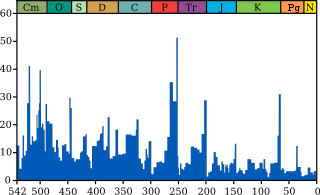Clathrate gun hypothesis
Indeed, cores of greater than 10 centimeters' contiguous depth had only been found in three sites as of 2000, and some resource reserve size estimates for specific deposits/locations have been based primarily on seismology.
[11] A study from 2010 concluded with the possibility for a trigger of abrupt climate warming based on metastable methane clathrates in the East Siberian Arctic Shelf (ESAS) region.
[15][16] While there were major dissociation events during the last deglaciation, with Bølling–Allerød warming triggering the disappearance of the entire methane hydrate deposit in the Barents Sea within 5000 years, those events failed to counteract the onset of a major Younger Dryas cooling period, suggesting that most of the methane stayed within the seawater after being liberated from the seafloor deposits, with very little entering the atmosphere.
[30] In 2007, chemical markers of surface temperature (TEX86) had also indicated that warming occurred around 3,000 years before the carbon isotope excursion, although this did not seem to hold true for all cores.
[32] Moreover, the small apparent change in TEX86 that precede the δ13C anomaly can easily (and more plausibly) be ascribed to local variability (especially on the Atlantic coastal plain, e.g. Sluijs, et al., 2007) as the TEX86 paleo-thermometer is prone to significant biological effects.
The δ18O of benthic or planktonic forams does not show any pre-warming in any of these localities, and in an ice-free world, it is generally a much more reliable indicator of past ocean temperatures.
A gradual release of the gas would allow it to be oxidised in the deep ocean, which would make benthic foraminifera show lighter values earlier.
The most parsimonious interpretation for surface-water foraminifera to show the δ13C excursion before their benthic counterparts (as in the Thomas et al. paper) is that the perturbation occurred from the top down, and not the bottom up.
[35] One study, however, suggests that because seawater oxygen content was lower, sufficient methane clathrate deposits could have been present to make them a viable mechanism for explaining the isotopic changes.
[39] A 2011 study, using numerical simulations suggests that enhanced organic carbon sedimentation and methanogenesis could have compensated for the smaller volume of hydrate stability.
[86][87] This is the first, largest, and fastest of a series of excursions (decreases and increases) in the ratio, until it abruptly stabilised in the middle Triassic, followed soon afterwards by the recovery of calcifying shelled sealife.
[93][94] While a variety of factors may have contributed to the ratio drop, a 2002 review found most of them insufficient to account for the observed amount:[75] However, the clathrate hypothesis has also been criticized.
[106] However, the East Siberian Arctic Shelf averages 45 meters in depth, and it is assumed that below the seafloor, sealed by sub-sea permafrost layers, hydrates deposits are located.
[107][108] This would mean that when the warming potentially talik or pingo-like features within the shelf, they would also serve as gas migration pathways for the formerly frozen methane, and a lot of attention has been paid to that possibility.
A release on this scale would increase the methane content of the planet's atmosphere by a factor of twelve,[112][113] equivalent in greenhouse effect to a doubling in the 2008 level of CO2.
At the time, some of the melting was thought to be the result of geological heating, but more thawing was believed to be due to the greatly increased volumes of meltwater being discharged from the Siberian rivers flowing north.
[124] By 2013, the same team of researchers used multiple sonar observations to quantify the density of bubbles emanating from subsea permafrost into the ocean (a process called ebullition), and found that 100–630 mg methane per square meter is emitted daily along the East Siberian Arctic Shelf (ESAS), into the water column.
However, Arctic cyclones, fueled by global warming, and further accumulation of greenhouse gases in the atmosphere could contribute to more rapid methane release from this source.
They conclude that the increased methane flux started hundreds to thousands of years ago, noted about it, "..episodic ventilation of deep reservoirs rather than warming-induced gas hydrate dissociation.
Understanding how methane interacts with other important geological, chemical and biological processes in the Earth system is essential and should be the emphasis of our scientific community.
[129]Research by Wallmann et al. (2018) concluded that hydrate dissociation at Svalbard 8,000 years ago was due to isostatic rebound (continental uplift following deglaciation).
[130] Moreover, another paper published in 2017 found that only 0.07% of the methane released from the gas hydrate dissociation at Svalbard appears to reach the atmosphere, and usually only when the wind speeds were low.
[132] Finally, a paper published in 2017 indicated that the methane emissions from at least one seep field at Svalbard were more than compensated for by the enhanced carbon dioxide uptake due to the greatly increased phytoplankton activity in this nutrient-rich water.
[133] In 2014 based on their research on the northern United States Atlantic marine continental margins from Cape Hatteras to Georges Bank, a group of scientists from the US Geological Survey, the Department of Geosciences, Mississippi State University, Department of Geological Sciences, Brown University and Earth Resources Technology, found widespread leakage of methane from the seafloor, but they did not assign specific dates, beyond suggesting that some of the seeps were more than 1000 years old.
In June 2017, scientists from the Center for Arctic Gas Hydrate (CAGE), Environment and Climate at the University of Tromsø, published a study describing over a hundred ocean sediment craters, some 300 meters wide and up to 30 meters deep, formed due to explosive eruptions, attributed to destabilizing methane hydrates, following ice-sheet retreat during the last glacial period, around 15,000 years ago, a few centuries after the Bølling–Allerød warming.
[6] In 2021, the IPCC Sixth Assessment Report no longer included methane hydrates in the list of potential tipping points, and says that "it is very unlikely that CH4 emissions from clathrates will substantially warm the climate system over the next few centuries.











